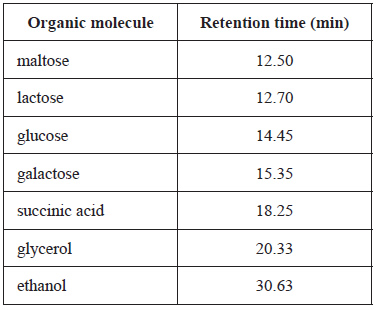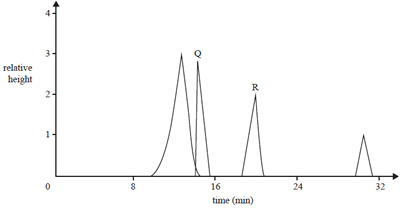1) Researchers have developed a technique that allows high-performance liquid chromatography (HPLC) to
simultaneously determine the concentration of sugar, organic acids and alcohols in fermentation products and food samples. The table below shows the retention times for some common organic molecules using
this technique.

Below is a chromatogram of four organic molecules.

a) Identify the substances responsible for each of the peaks Q and R.
Solution
b) Two substances have different retention times under identical conditions using the same HPLC equipment.
Explain this difference in retention times.
Solution

c) Miscanthus floridulus is a type of grass that is approximately 37% cellulose by mass. M. floridulus is being researched as a feedstock for bioethanol,
CH3CH2OH, production. The cellulose in this grass
can be used to produce CH3CH2OH, as summarised in the flow chart below. In each step of thisprocess, there is incomplete conversion and waste products are formed.
.
HPLC can be used to determine the concentration of fermentation products at different points in the process.
i. Researchers use percentage by mass of CH3CH2OH produced to make comparisons between different grasses as feedstocks. Using HPLC, a researcher determined that 144 L of CH3CH2OH
was produced from 1000 kg of M. floridulus.
i.
Calculate the percentage by mass of CH3CH2OH produced from the mass of cellulose in M. floridulus, assuming the density of CH3CH2OH is 0.79 g mL–1.
Solution
ii. Calculate the amount of energy, in kilojoules, that would be produced if complete combustion of 144 L of CH3CH2OH occurred.
Solution

d) CH3CH2OH can be added to petrol to make E10, a type of fuel containing 10% CH3CH2OH. Explain why E10 is more viscous than regular petrol under the same conditions.
Solution